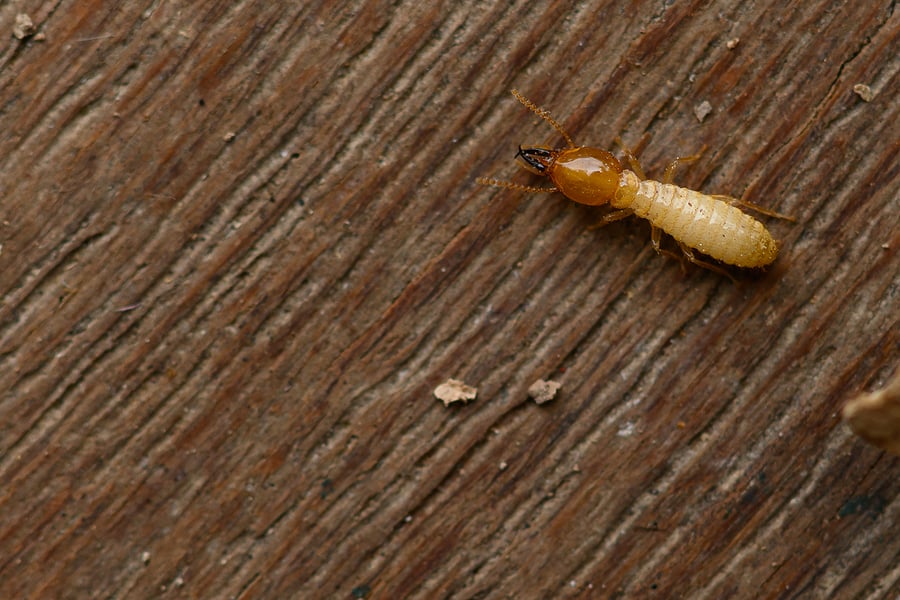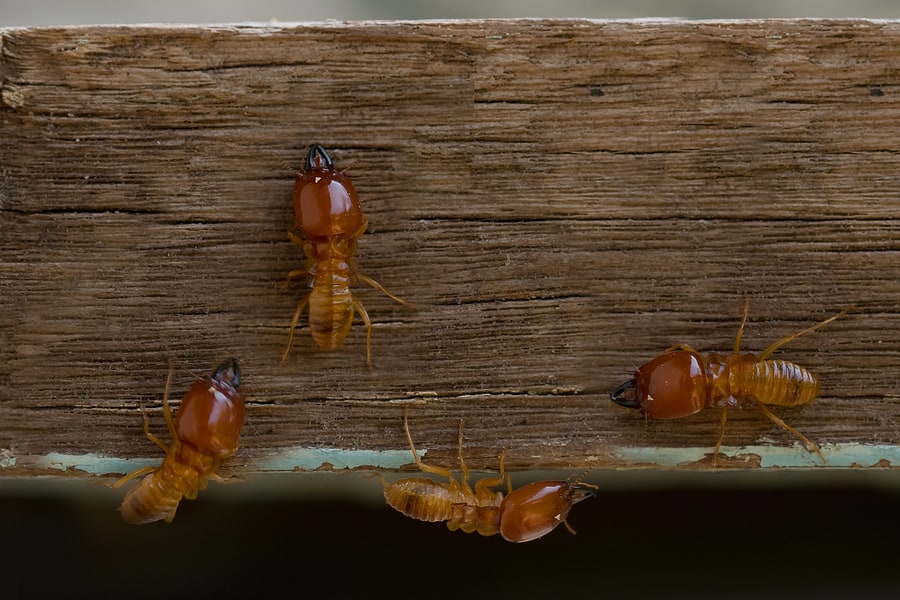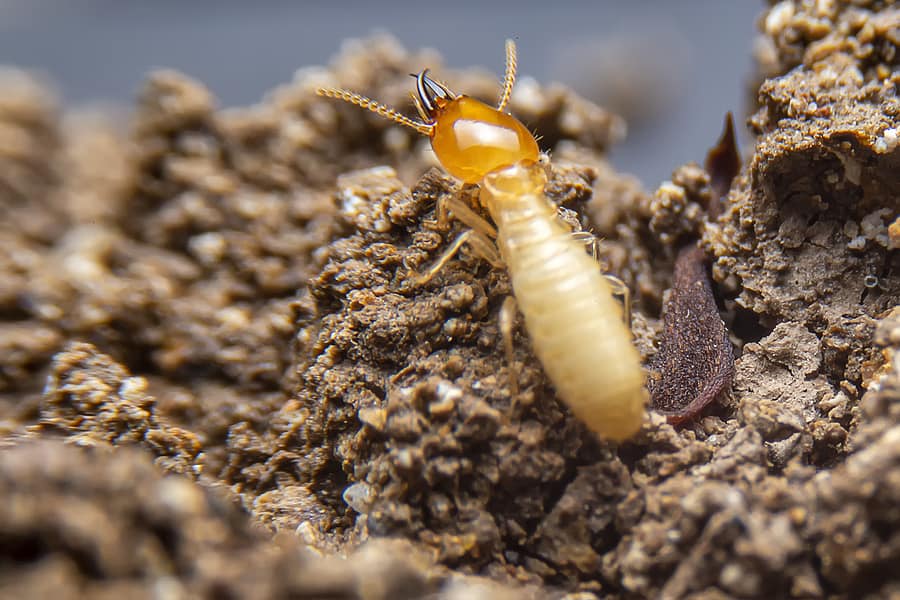READY TO GET STARTED?
REQUEST A FREE ESTIMATE
Fill out the form below or call (888) 466-7849 for a free, no-obligation estimate.

Termites are considered a year-round pest, causing significant destruction to homes and properties each year. Termite swarming season runs from spring to summer for most species. They use this time to reproduce and establish new colonies. Keep your home safe from termites this summer with these termite prevention tips.
Termite inspections aren’t limited to just your house. Make sure to inspect any wooden structures you have outside, as well, like wood furniture, swing sets, and decks. Termites will make small pinholes in the wood they are eating. If you find evidence of termites in your wooden structures, contact a termite control professional immediately. If your structures are not infested, seal them with an outdoor paint or sealant.
Installing a barrier to entry for termites will go a long way towards keeping them out of your home for good. There are two termite treatment options available for the perimeter of your home: bait stations and liquid soil treatments. In addition to these, performing routine inspections of the outside of your home, especially around foundations, is critical. If any gaps or cracks are found, seal or repair them immediately.
Stacks of firewood are an ideal food source for termites. Try not to stack firewood next to your home, shed or garage. Instead, store it several feet away from these structures. You should also elevate it, if possible, on either metal or concrete racks.
It’s important to keep your yard maintained to help prevent termites and other pests. Keep bushes and trees trimmed back so they are not touching your house or overhanging. Remove any dead or dying shrubs from your yard. Try to avoid using wooden mulch; instead, opt for recycled rubber mulch.
Termites don’t take days off so your home is always at risk. They can also go undetected for long periods of time, causing significant damage before you even realize they are there. A pest control professional can perform an annual termite inspection to help spot any signs of termites before they turn into a full blown termite infestation.
If you have a problem with termites or just want to get a head start on prevention, contact your local pest control company for a complete evaluation.
Why Do I Have Ants in My Kitchen?

Termites cost homeowners billions of dollars each year. Known as silent destroyers, these pests eat wood from the inside out, going long periods of time undetected in your home. Treating termites depends on the type of termite you have. The most common are drywood termites, dampwood termites, and subterranean termites.
You can protect your home from termites by having an annual termite inspection performed on your home. A termite technician will come out once a year and inspect the inside and outside of your home for signs of termites. You can also help prevent termites by keeping soil around your home dry, making sure landscaping doesn’t touch foundations, fixing leaks, and using concrete for foundations.
Sometimes despite our best efforts, termites invade our home. Once they get in, professional termite treatments are necessary to completely eliminate the infestation. The type of treatment you use depends on the type of termite you have. The three most common types of treatments include liquid-soil treatments, bait stations, and sprays/foams.
One of the most important questions any homeowner wants to know when treating termites is how long the treatment takes to work.
Termites can be a big headache for homeowners. If you have a problem with termites or just want to get ahead with prevention, contact a pest control company who can provide you with a thorough inspection and termite control plan that works best for your situation.
What Types of Grasses Work for My Georgia Lawn?
5 Signs You May Need an Exterminator
Termites can cause serious damage to your home, affecting both its structure and integrity. Termite damage can also be costly to repair. Let’s take a closer look at how to recognize when you have a termite problem, as well as the different types of termite treatments that are available today.
The first step in preventing termites is to identify when you have a problem. Termites eat wood from the inside out so they often go undetected for long periods of time, causing substantial damage before you even realize you have a problem. Recognizing the signs of termites in your home is a good first step to identifying their presence. Common signs of termites include:
The best way to control termites is to prevent them in the first place. Some common termite prevention tips include:
Once you have an established termite infestation, the next step is deciding which termite control treatment is best for your situation. Treatments depend on a variety of factors including the type of termite you are dealing with, the severity of the infestation, the type and size of your home, whether it is a new construction or an existing home, the cost of the treatment, and more. There are four main types of termite treatments:
Liquid-soil termite treatments are used on the soil surrounding your home to act as a treatment barrier. They are long lasting, providing protection for an average of 5 years. With these treatments, a trench is dug around the perimeter of your home and liquid termiticide is applied. The trench is then filled back in. This method helps prevent future infestations, as well as killing any existing termites as they travel between your home and their nests.
Bait station treatments are another option for treating termites. In this method, bait stations are strategically placed around your home. Each station contains a slow-acting termiticide that the termites take back to their nests and share with other termites. These treatments can take longer to affect termites. They also require regular monitoring and maintenance to make sure each station still contains bait.
Wood treatments offer another alternative to termite control. These treatments utilize either surface sprays and treatments or injected sprays and foams. Wood treatments kill existing termites and also soak into the wood to prevent future problems. These treatments require direct access to infested wood which can be difficult to get to in some circumstances. Sprays are better for use in new construction treatments as the wood can be treated as the house is being built. Injected foams are better for use on existing structures as they can expand into cracks and crevices that sprays may not be able to reach.
Pre-treated building materials are best used for new construction. The termiticide can either be sprayed or brushed on. Termiticide can also be applied anywhere the new structure comes into contact with the soil, allowing the soil to be pretreated. Using pressure treated wood is also an option as termites are less likely to infest wood that has been mixed with chemicals.
Termites are a serious problem for homeowners. If you suspect you have a problem with termites or other pests, contact your local pest control company for an inspection.
Protecting Your Pets from Fleas and Ticks
What Happens During the Bee Relocation Process?
When Should Mosquito Treatments Start?

Termites cause costly and considerable damage to homes and property each year. These pests are known to go undetected for some time, making it more challenging to eliminate them. It’s necessary to know the warning signs of termites and how to prevent them from infesting your home.
Termites need water to survive. They will seek moist, wet areas inside or around your home to build a new colony site and utilize the water to survive. Eliminating unnecessary moisture both inside and outside of your home is a great start to termite prevention. Storm drains should always be directed away from your house, draining at least a few feet from the foundation. Inside, ensure that there are no leaky faucets or water pipes. If there are leaks, fix them as soon as possible. If your home has a crawlspace, consider investing in a crawlspace enclosure which will help eliminate moisture under the house while also preventing mold, wood rot, and other pests.
In addition to searching for water, termites also search for wood. If there is any exposed wood around your house that is easily accessible to termites, they will find it and destroy it. Reducing soil-to-wood contact around your home is essential in preventing them. Get rid of any lumber, mulch, plants, or other wood items that are around your foundation. If you do want to use mulch for landscape purposes, keep at least a 4-inch barrier between the mulch and the side of your home. Always clean up and get rid of fallen branches, dead wood, or old tree stumps throughout your property.
Termites can be extremely difficult to detect, prevent, and eliminate once they are established. If you suspect or discover that you have a termite problem, or even want to get ahead of the prevention game, contact a professional pest control company who can set you up with annual termite inspections and even a termite control plan.

Termites cause billions of dollars in damage to homes each year. This irreparable damage can affect both the structure and the integrity of your home. It is projected that homeowners spend upwards of $2 billion on termite treatments each year. Termites eat wood from the inside out, allowing them to go undetected for long periods of time and causing significant damage before you even realize it. Oftentimes homeowners aren’t aware of the presence of termites until they discover this damage.
The most common type of termite in the United States is the subterranean termite, although drywood termites, dampwood termites and Formosan termites can also be found here. Some of the most common signs of termites in your home include termite swarms; mud tubes on or around foundations; piles of discarded wings; drooping or discolored drywall; paint that is peeling; wood that makes a hollow sound when you tap on it; squeaking floorboards; doors and windows that stick; damaged or crumbling wood; loose tile; buckling floors; and even small holes in your drywall.
There are three main methods of termite treatment and the effectiveness of each depends on the type of termite you are dealing with and the severity of the infestation. Here is a breakdown of all three, along with some termite prevention tips to help protect your home from termite damage.
Soil treatments are applied to the soil that surrounds your home to create a barrier. The first step is to dig a trench around your foundation. This soil is then treated with a termiticide and the trench is filled back in. By doing this, termites are killed as they pass through the chemicals on their way back to their nests.
Wood treatments are used to both kill existing termite colonies and also prevent future ones from starting. There are different types of wood treatments all used with varying effectiveness depending on the type of termite and the severity of the infestation. Surface sprays are treatments that are applied to the surface of wood. Injected sprays and foams are applied to the inside of wood. Borate treated wood is wood that is pretreated with a borate solution. Gas fumigation entails using fumigants that permeate throughout your entire home which disrupts the metabolism of the termites. Surface sprays and borate treated wood are usually used during construction or renovation of homes. Injections, foams, and fumigants are used after a home is built.
Bait systems are most effective at destroying termite colonies. A termite control professional will come out and install the bait stations around the outside perimeter of your home. These stations are then monitored on a regularly scheduled basis. Bait stations help ensure your home is protected from both a current infestation and a future one. The bait stations contain chemicals that termites eat and then take back to their colonies which allows it to be spread to others. This type of termite treatment is most effective with larger termite colonies.
How do you know which type of treatment is best for you? That all depends on the type of termite you are dealing with. Subterranean termites typically nest underground and enter homes where the wood structure makes direct contact with the soil. They will often squeeze through cracks in the foundation or around utility pipes through mud tubes. The best treatment for these termites is either a soil treatment or a bait station.
Drywood termites don’t require direct soil contact for survival. These termites will colonize anywhere they can find a preferred source of wood. They also don’t need as much moisture to survive like other termite species do. Drywood termites are often found in attics, dead or dying trees and shrubs, utility poles, fencing, and furniture. These termites are most effectively treated with gas fumigation or targeted termiticide.
Dampwood termites are much larger in size than their subterranean counterparts. They also have large pincers that they use to fight off predators. They typically colonize damp or decaying wood with higher moisture content like that found in logs and stumps. These termites don’t usually make their nests in the soil or build mud tubes. They are also not usually as destructive as other termite species are. The best treatment for these termites is moisture removal and termiticide application.
The best way to get a head start on termite control at home is through prevention. Most homeowners policies do not cover termite damage so keeping them away is critical to protect both your home and your wallet. You can prevent termites by:
If you suspect you have a problem with termites or you just want to get ahead with a prevention plan, contact your local pest control company who can provide you with a free analysis and set you up with a successful treatment and prevention plan going forward.
The Importance of Mosquito Treatments
How to Prepare for Snake Season